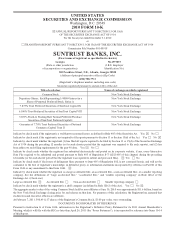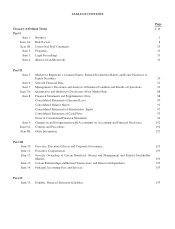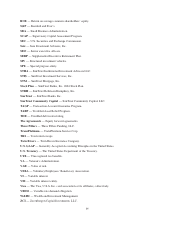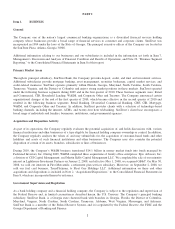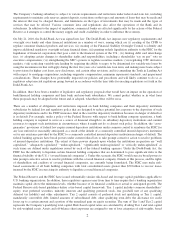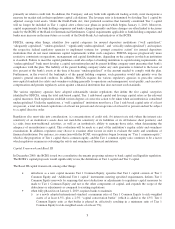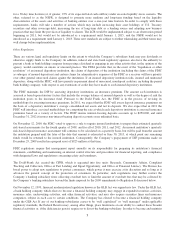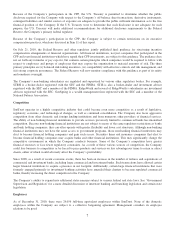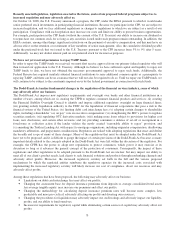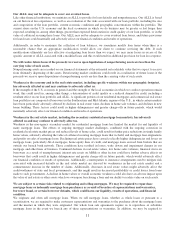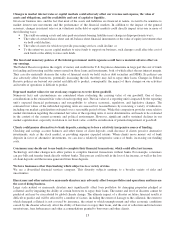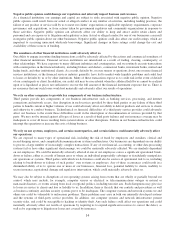SunTrust 2010 Annual Report Download - page 21
Download and view the complete annual report
Please find page 21 of the 2010 SunTrust annual report below. You can navigate through the pages in the report by either clicking on the pages listed below, or by using the keyword search tool below to find specific information within the annual report.for a 30-day time horizon (or, if greater, 25% of its expected total cash outflow) under an acute liquidity stress scenario. The
other, referred to as the NSFR, is designed to promote more medium and long-term funding based on the liquidity
characteristics of the assets and activities of banking entities over a one-year time horizon. In order to comply with these
requirements, banks will take a number of actions which may include increasing their asset holdings of U.S. Treasury
securities and other sovereign debt, increasing the use of long-term debt as a funding source and adopting new business
practices that may limit the provision of liquidity to clients. The LCR would be implemented subject to an observation period
beginning in 2011, but would not be introduced as a requirement until January 1, 2015, and the NSFR would not be
introduced as a requirement until January 1, 2018. These new standards are subject to further rulemaking and their terms may
well change before implementation.
Other Regulation
There are various legal and regulatory limits on the extent to which the Company’s subsidiary bank may pay dividends or
otherwise supply funds to the Company. In addition, federal and state bank regulatory agencies also have the authority to
prevent a bank or bank holding company from paying a dividend or engaging in any other activity that, in the opinion of the
agency, would constitute an unsafe or unsound practice. The FDIA provides that, in the event of the “liquidation or other
resolution” of an insured depository institution, the claims of depositors of the institution (including the claims of the FDIC
as subrogee of insured depositors) and certain claims for administrative expenses of the FDIC as a receiver will have priority
over other general unsecured claims against the institution. If an insured depository institution fails, insured and uninsured
depositors, along with the FDIC, will have priority in payment ahead of unsecured, nondeposit creditors, including the parent
bank holding company, with respect to any extensions of credit they have made to such insured depository institution.
The FDIC maintains the DIF by assessing depository institutions an insurance premium. The amount each institution is
assessed is based upon statutory factors that include the average balance of insured deposits as well as the degree of risk the
institution poses to the insurance fund. Pursuant to the Dodd Frank Act, the FDIC is in the process of revising its
methodology for assessing insurance premiums. In 2011, we expect that the FDIC will assess deposit insurance premiums on
the basis of a depository institution’s average consolidated net assets and not its deposits. We also expect that in 2011 the
FDIC will introduce a revised methodology for computing the rate at which each depository institution is assessed insurance
premiums based on a variety of factors. The FDIC insures interest–bearing deposits accounts up to $250,000, and until
December 31, 2012 it insures non-interest bearing deposit accounts on an unlimited basis.
On November 12, 2009, the FDIC voted to approve a rule to require insured institutions to prepay their estimated quarterly
risk-based assessments for the fourth quarter of 2009, and for all of 2010, 2011, and 2012. An insured institution’s quarterly
risk-based deposit insurance assessment will continue to be calculated on a quarterly basis, but will be paid from the amount
the institution prepaid until the later of the date that amount is exhausted or June 30, 2013, at which point any remaining
funds would be returned to the insured institution. Consequently, the Company’s prepayment of DIF premiums made on
December 29, 2009 resulted in a prepaid asset of $925 million at that time.
FDIC regulations require that management report annually on its responsibility for preparing its institution’s financial
statements, establishing and maintaining an internal control structure and procedures for financial reporting, and compliance
with designated laws and regulations concerning safety and soundness.
The Dodd-Frank Act created the CFPB, which is separated into five units: Research, Community Affairs, Complaint
Tracking and Collection, Office of Fair Lending and Equal Opportunity, and Office of Financial Literacy. The Bureau has
broad power to adopt new regulations to protect consumers, which power it may exercise at its discretion and so long as it
advances the general concept of the protection of consumers. In particular, such regulations may further restrict the
Company’s banking subsidiary from collecting overdraft fees or limit the amount of overdraft fees that may be collected by
the Company’s banking subsidiary beyond the limits imposed by the 2009 amendments to Regulation E discussed below.
On November 12, 1999, financial modernization legislation known as the GLB Act was signed into law. Under the GLB Act,
a bank holding company which elects to become a financial holding company may engage in expanded securities activities,
insurance sales, underwriting activities, and other financial activities, and may also acquire securities firms and insurance
companies, subject in each case to certain conditions. The Company has elected to become a financial holding company
under the GLB Act. If any of our banking subsidiaries ceases to be “well capitalized” or “well managed” under applicable
regulatory standards, the Federal Reserve may, among other things, place limitations on our ability to conduct these broader
financial activities or, if the deficiencies persist, require us to divest the banking subsidiary. In order to become and maintain
5


